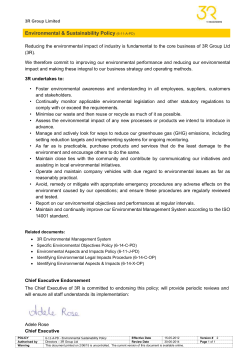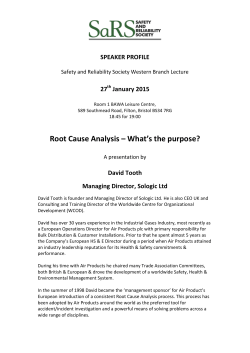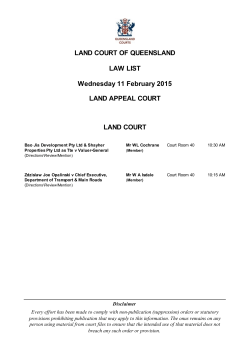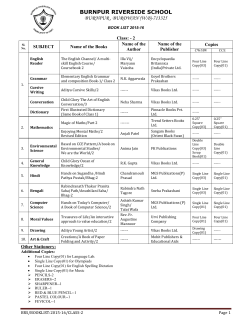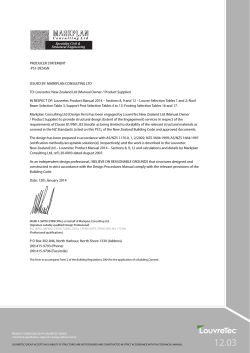
Lotus India - APA Presentation - The Chamber of Tax Consultants
Transfer Pricing Issues - IT/ITES Industry - Financial Services Industry Darpan Mehta March 20, 2015 Agenda IT/ITES Industry 1 Financial Services Industry 2 Slide 2 IT/ITES Industry 1 Issues and challenges Why IT/ITeS? Favourite area for transfer pricing assessments in India – sector dominated by MNCs. Most common approach to establish ALP is to apply TNMM. No tax holiday on TP adjustments Transactions resulting in more than ordinary profits, excess disallowed. Transition from tax holiday to non-tax holiday Potential areas?! -Permanent Establishments - Attribution of location savings for Niche researches undertaken Slide 4 Issues and challenges Comparability, key area of focus Large outbound multinationals having turnover multiple times when compared to the low-end captives are often not appreciated by tax authorities. Several ITAT rulings have examined and ruled on comparability aspects considering functions, assets and risk (FAR) analysis, turnover criteria, etc. Few examples – Infosys, Wipro, Tata Elxsi, I-Gate, E-clerx, etc. TPOs continue to select these companies as comparable. Low end back office support services (BPOs) and high-end service providers (KPOs) – Not differentiated Tax authorities disregard the qualification/skill sets of employees and re-characterize taxpayers as KPO (which requires them to earn high profit margin) and accordingly make adjustments New areas of comparability are being looked at every year & Increasing focus on the high end functions of the tax payer Slide 5 Issues and challenges Typical favourites of tax administration IT/Software development services segment IT enabled services segment Infosys Technologies Ltd. Infosys BPO Ltd. Kals Information Systems Ltd. Accentia Technologies Ltd. Wipro Ltd. TCS e-serve Ltd. Tata Elxsi Ltd. TCS e-serve International Ltd. Acropetal Technologies Ltd. E-clerx Services Ltd. Moldtek Coral hubs Ltd Slide 6 Issues and challenges Other key issues faced during assessments 1.Use of single year data – TPOs and appellate authorities have consistently denied use of multiple year data 2.Secret comparables - use of powers conferred u/s 133(6) 3.Rejection of filters adopted by tax payer 4.Rejection of TP documentation maintained – liberal use of powers u/s 92C(3) 5.Re-perform tax payer’s qualitative BM analysis and choose high margin companies 6.Challenges in PLI computation for comparables: pass through costs; un-realised foreign exchange loss/gain 7.Denial of economic adjustments such as risk adjustment, working capital adjustments, etc. Slide 7 Issues and challenges Substance over Form Substance over form creates further anxiety during audits, certain instances: 1. Terms as per inter-company agreements - scope of work, etc. While the actual work performed would be that of back office support or low end IT services, scope of services in the inter-company agreements would be more elaborate and indicate high end services. Invoices may further not speak the language of the actual service provision. 2. Billing – hourly rates vs. cost plus While the functions performed would be that of a captive, be it IT/ITeS, the remuneration model would not indicate the same. Further, behaviour of the tax payer for the purpose of retaining profits in tax holiday units. 3. Where in value chain? TPOs often tend to oversee the position/roles of the tax payer in the entire value chain of Group companies’ business. Slide 8 Issues and challenges Entrepreneurs vs. captives – need for differentiation Differences in the functions and risks between entrepreneurial IT/ITeS companies and captive IT/ITeS companies: Entrepreneurial companies Captive companies Operates on a time & material (T&M) basis with a split for man hour charges for offshore and onshore Operates as a part of the in-house team of the parent generally operating as a wholly owned subsidiary of the parent Business model – extended arm of the client & generally provide access to source codes and IPR for execution of the contract Business model - provided with access to all source codes along with technical know-how. Does business development and marketing of the services. No marketing element involved Responsible for warranties on the programmes developed along with provision support upto certain period of time. Captives does not take any warranty for the programmes developed Generally end-to-end projects are sought by customers Involved in providing low-end support to the services provided by parent Slide 9 Issues and challenges Certain case laws… contd… Captives do not constitute PEs The Hon’ble Delhi High Court in the context of Permanent Establishment, rendered in the case of efunds Corporation and e-funds IT Solutions Inc. that an Indian subsidiary, on a standalone basis or by itself, would not create a PE of the foreign principal. Disallowance - Super normal profits Hon’ble Pune Tribunal decision in the case of Tweezerman India P Ltd. TS-344-ITAT2013(CHNY)-TP held that the AO was not right in disallowance of deduction u/s 10B on excess transaction price over ALP. [In this case, the AO held that the benefit u/s 10B was disallowable to the extent of excess of assessee's profit for computation of Sec. 10B over arm's length profit determine by the TPO. Accordingly, it was held that the assessee was not entitled to Sec. 10B benefit on Rs. 3.66Cr.] Slide 10 Issues and challenges Certain case laws… contd… BPO vs KPO & High Profit comparables Hon’ble Mumbai Tribunal (SB) decision in the case of Maersk ruled on the following important principles. • ITES services could not be further bifurcated or classified as BPO and KPO services for the purpose of comparability analysis. If a taxpayer was found to have provided low-end back office support services like voice or data processing services as a whole, or substantially the whole, then companies providing mainly high-end services by using their specialized knowledge and domain expertise could not be considered as comparables. • Potential comparables could not be excluded merely on the ground that their profit was abnormally high. Abnormally high profit margin should trigger further investigation, including profit margin earned in the immediately preceding year/s to find out whether the high profit margin represented the normal business trend. If the high profit margin did not reflect normal business conditions, the high profit margin making entity should not be included in the list of comparables. Slide 11 Safe Harbour Rules Coverage and rates # Eligible International Transaction Proposed Safe Harbour (OP/OE not less than) 1. Software development services* 2. Information technology enabled services* 3. KPO 25% - no range 4. Contract R&D services (software) 30% - no range 20% for transaction value up to INR 5 Billion; 22% for transaction greater than INR 5 Billion * With insignificant risk Operating Income Excludes (a) interest income; Operating Expense Excludes (a) interest expense; (b) income arising on account of foreign currency fluctuations; (b) provision for unascertained liabilities; (c) income on sale of assets/investments; (c) pre-operating expenses; (d) refunds relating to income tax expense; (d) loss arising on account of foreign currency fluctuations; (e) provisions no longer required written back; (e) extra-ordinary expenses; (f) extra-ordinary items; (f) loss on transfer of assets/investments of; (g) other incomes not relating to operating activities (g) expenses on account of income-tax; (h) other expenses not relating to operating activities Slide 12 Safe Harbour Rules Insignificant risk The description of an eligible taxpayer with insignificant risk is in line with criteria prescribed in a recently issued Circular (No. 6/2013 dated 29 June, 2013) Foreign Principal Indian Service Provider (ICo) Economically significant functions ICo is largely involved in economically insignificant (Conceptualisation, Design, etc.) functions Funds/capital and other economically ICo does not use any other economically significant significant assets including intangibles assets including intangibles Capability to control or supervise through its strategic decisions to perform core ICo works under direct supervision of foreign principal functions as well as monitor activities ICo does not assume or has no economically significant Assumption of risks realised risks Ownership right (legal or economic) on outcome of research ICo has no ownership right on outcome of research which shall also be evident from conduct of the parties Slide 13 Issues and challenges Learning lessons Detailed FAR / BM Analysis Robust TP documentationAlignment of Form & Substance Supplement Analysis Learning Lessons Suo-moto adjustment Timely representation Periodic review of TP policy & inter-company agreements Slide 14 Financial Services Industry 2 Private Equity and Asset Management Issues Funds • An Indian company provides nonbinding investment recommendations receives a cost plus mark-up in the range of 15% to 20% • During TP audits, mark-ups upwards of 50% applied by tax authorities by selecting asset management companies and investment bankers as comparables (Tribunals have granted relief in various cases such as Carlyle, Bain Capital, Tamasek, etc) • Possible approach • Certainty on methodology, characterisation (Indian entity and AEs) and mark-up Investment management agreement Investment Manager Investment Advisory agreement Investment Advisor Outside India India Sub- Advisory / Consultancy agreements Investment sub-advisor • Fund raising and investor relations • Investment management • Evaluation of opportunities • Final decision making • Identification and advising Manager • Screening & evaluation of Sub-advisor’s recommendation • Preliminary analysis • Detailed analysis • Support / monitoring services Slide 16 Equity Broking Issues AE FII client 3P FII clients • Transactional Net Margin Method (‘TNMM’) selected as the most appropriate method by the tax payer. • Comparable Uncontrolled Price (‘CUP’) Method applied by the Indian tax authorities using other third party (3P) transactions. Overseas Possible approaches India • Selection of most appropriate method Indian Broker - Use of TNMM considering various products and operational mechanism selected. - In case of CUP, agree on mechanics for adjustment towards: Domestic clients Brokerage income FII - Foreign Institutional Investor ◦ Distinguishing functions performed for AEs vis-à-vis non AEs (i.e. marketing, research) and it impact on pricing. ◦ Consideration of volume adjustments on pricing brokerage rates. Slide 17 Investment Banking Type of IB transactions / deals 1. Mergers & Acquisitions 3. Underwriting 2. Debt and Equity Capital Market Typical functions Typical pricing mechanisms 1. Origination 3. Structuring 2. Execution 4. Distribution / Underwriting 1. Pooling of revenues and costs & profit split based on key driver 2. Revenue split on deal by deal basis Allocation keys / Weights Most Appropriate Method 1. Market Surveys 3. HR Index 2. Employee cost 4. Time spent Integrated functions 1. Revenue Split (Other Method) 2. Profit Split Method Support functions 1. TNMM Slide 18 Investment Banking Key points for consideration : • Application of global policy to Indian operations / basis of pricing • Consistent allocation for profits and losses • Confirmation on basis of allocation /application of global policy (e.g. compensation, HR index, etc.) • Framework for treatment of policy exceptions, if any Slide 19 Key Issues in Financial Services Cost Allocations Generally large Banking Groups centralise various support functions such as IT, Legal, Finance, HR on a global / regional level and such costs are allocated across affiliates, including Indian entity, on the basis of reasonable allocation keys (with or without mark-ups) Typical Issues Possible approaches • Demonstration of benefit test analysis with adequate documentation • Guidance on level of documentation that could be maintained on an annual basis to demonstrate receipt of benefits • Determining whether there is any duplication of services / shareholder costs being charged • Certainty on the allocation basis • Determining the appropriateness of the cost pool and allocation keys used • Documentation to support accuracy of cost allocation to India – audited statements • Justification for charging a mark-up, if any • Confirmation on mark-up on certain costs • Absence of independent Accountant’s Certificate to support the amount allocated to India • No deduction available to India bank branch, in absence of actual payment Slide 20 Offshore Loans Typical Functions / Risks Overseas Branch ABC Bank Singapore Loan advanced by Singapore branch to the third party borrower Functions • Sales conclusion • Loan management • Risk assumption • Capital Raising Fees and interest paid by third party borrower to Singapore branch Risks • Credit risk • Interest rate risk • Liquidity risk Overseas India Third party borrower Assists in loan origination and sales support Approaches Indian branch for foreign currency loan ABC Bank India branch India Branch Functions • Origination and sales support (documentation, credit review support, etc.) • Loan monitoring and administration Risks • Operational risk (minimal) • Reputational risk Slide 21 Offshore Loans Typical Issues Possible approaches • Scrutiny to analyze role of each group entity and whether pricing commensurate with functions • Confirmation of functional analysis in relation to roles performed by India branch and overseas AE • Indian tax authorities typically adopt an approach to apply a percentage in the range of 20 to 25% of the net income to the originating location • Arm’s length pricing based on comparability analysis, considering:- • Varied fee split mechanisms adopted by the industry players - Approaches based on global databases such as LoanConnector, Deal Scan, etc. that provide data as a proxy for origination, support functions. - Back Testing / corroborating results - Using internal data, if available Slide 22 Questions? Thank You Slide 24
© Copyright 2025
